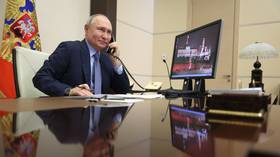Surging Russian stocks continue to drive investor interest despite US sanctions

Global investors have been returning to Russian assets this year, pouring more money into the country over signs of its strengthening economy. The growth comes despite US sanctions targeting Russia's financial sector.
The ruble-based MOEX Russia Index has surged over 27 percent so far this year, while the dollar-denominated RTS was up over 40 percent. Russian equities have outpaced most other emerging market stocks and kept pace with the S&P 500, an index of the top 500 US corporations.
The MSCI Russia Index, which tracks the 23 largest Russian publicly-listed companies, has surged 44 percent since the start of the year, according to Sberbank analyst Cole Akeson.
“What we have in Russia is dividends growing, stable finances, and more and more investors starting to appreciate [that] it is a relatively safe bet,” Marcin Lewczuk, a partner at investment firm Mobius Capital Partners, told the Wall Street Journal.
The stock market’s current surge has been driven by higher global risk appetite and a search for higher-paying assets amid interest rate cuts, according to Mikhail Ganelin, senior analyst at Aton. He said that it has benefited Russian stocks, which are seen as riskier and have lower levels of liquidity.
Russia’s economic growth is expected to climb to 1.7 percent in 2020, which will trail most other major emerging markets. The ruble has risen almost 11 percent against the US dollar in 2019, even as most other emerging-market currencies weakened.
The growth came despite US sanctions that were introduced in 2014 after Russia’s reunification with Crimea. The fresh round of sanctions which took place in August barred US banks from lending foreign currencies to the Russian government or participating in the primary market for non-ruble-denominated sovereign bonds.
“Can they ramp up sanctions a bit more? Yes,” Joseph Mouawad, emerging debt fund manager at the French investment firm Carmignac told the WSJ. “But is it a big game changer? No, because what the Russians have been doing is preparing.”
For more stories on economy & finance visit RT's business section














